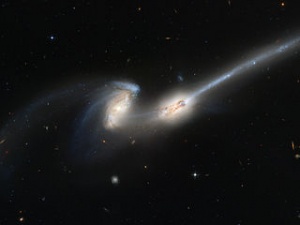Difference between revisions of "List of astronomical databases"
Jump to navigation
Jump to search
| Line 1: | Line 1: | ||
[[File:NGC4676.jpg|thumb|right|NGC-4676 or Mice galaxies.]] | |||
This is a '''list of astronomical databases'''. According to ESA, the number of galaxies in the observable universe is 2×10<sup>12</sup> (two trillion) and as many as 1×10<sup>24</sup> stars (more stars than all the grains of sand on planet Earth). | This is a '''list of astronomical databases'''. According to ESA, the number of galaxies in the observable universe is 2×10<sup>12</sup> (two trillion) and as many as 1×10<sup>24</sup> stars (more stars than all the grains of sand on planet Earth). | ||
Latest revision as of 19:15, 10 June 2020
This is a list of astronomical databases. According to ESA, the number of galaxies in the observable universe is 2×1012 (two trillion) and as many as 1×1024 stars (more stars than all the grains of sand on planet Earth).
- Guide Star Catalog [1] - GSC-I contains 19 million stars with apparent magnitudes of 6 to 15. GSC-II is an all-sky catalog of 2 billion stars and galaxies.
- Messier Catalogue [2] - A set of 110 astronomical objects catalogued by Charles Messier.
- New General Catalogue [3] - A set of 7,840 deep-sky objects compiled by John Louis Emil Dreyer.
